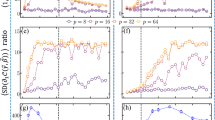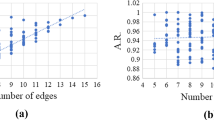Abstract
The quantum approximate optimization algorithm (QAOA) is a method of approximately solving combinatorial optimization problems. While QAOA is developed to solve a broad class of combinatorial optimization problems, it is not clear which classes of problems are best suited for it. One factor in demonstrating quantum advantage is the relationship between a problem instance and the circuit depth required to implement the QAOA method. As errors in noisy intermediate-scale quantum (NISQ) devices increase exponentially with circuit depth, identifying lower bounds on circuit depth can provide insights into when quantum advantage could be feasible. Here, we identify how the structure of problem instances can be used to identify lower bounds for circuit depth for each iteration of QAOA and examine the relationship between problem structure and the circuit depth for a variety of combinatorial optimization problems including MaxCut and MaxIndSet. Specifically, we show how to derive a graph, G, that describes a general combinatorial optimization problem and show that the depth of circuit is at least the chromatic index of G. By looking at the scaling of circuit depth, we argue that MaxCut, MaxIndSet, and some instances of vertex covering and Boolean satisfiability problems are suitable for QAOA approaches while knapsack and traveling salesperson problems are not.





Similar content being viewed by others
References
Farhi, E., Goldstone, J., Gutmann, S.: A quantum approximate optimization algorithm. arXiv preprint arXiv:1411.4028 (2014)
Guerreschi, G.G., Smelyanskiy, M.: Practical optimization for hybrid quantum-classical algorithms. arXiv preprint arXiv:1701.01450 (2017)
Streif, M., Leib, M.: Training the quantum approximate optimization algorithm without access to a quantum processing unit. arXiv preprint arXiv:1908.08862 (2019)
Shaydulin, R., Safro, I., Larson, J.: Multistart methods for quantum approximate optimization. In: 2019 IEEE High Performance Extreme Computing Conference (HPEC), pp. 1–8. IEEE (2019)
Farhi, E., Goldstone, J., Gutmann, S.: A quantum approximate optimization algorithm applied to a bounded occurrence constraint problem. arXiv preprint arXiv:1412.6062 (2014)
Zhou, L., Wang, S.-T., Choi, S., Pichler, H., Lukin, M.D.: Quantum approximate optimization algorithm: performance, mechanism, and implementation on near-term devices. arXiv preprint arXiv:1812.01041 (2018)
Fingerhuth, M., Babej, T., et al.: A quantum alternating operator ansatz with hard and soft constraints for lattice protein folding. arXiv preprint arXiv:1810.13411 (2018)
Cook, J., Eidenbenz, S., Bärtschi, A.: The quantum alternating operator ansatz on max-k vertex cover. arXiv preprint arXiv:1910.13483 (2019)
Huang, H.-Y., Bharti, K., Rebentrost, P.: Near-term quantum algorithms for linear systems of equations. arXiv preprint arXiv:1909.07344 (2019)
Saleem, Z.H.: Maximum independent set and quantum alternating operator ansatz. arXiv preprint arXiv:1905.04809 (2019)
Wang, Z., Hadfield, S., Jiang, Z., Rieffel, E.G.: Quantum approximate optimization algorithm for maxcut: a fermionic view. Phys. Rev. A 97(2), 022304 (2018)
Crooks, G.E.: Performance of the quantum approximate optimization algorithm on the maximum cut problem. arXiv preprint arXiv:1811.08419 (2018)
Guerreschi, G.G., Matsuura, A.Y.: Qaoa for max-cut requires hundreds of qubits for quantum speed-up. Sci. Rep. 9, 1–7 (2019)
Farhi, E., Harrow, A.W.: Quantum supremacy through the quantum approximate optimization algorithm. arXiv preprint arXiv:1602.07674 (2019)
Wang, Z., Rubin, N.C., Dominy, J.M., Rieffel, E.G.: \(xy\)-mixers: analytical and numerical results for qaoa. arXiv preprint arXiv:1904.09314 (2019)
Xue, C., Chen, Z.-Y., Wu, Y.-C., Guo, G.-P.: Effects of quantum noise on quantum approximate optimization algorithm. arXiv preprint arXiv:1909.02196 (2019)
Wang, S., Fontana, E., Cerezo, M., Sharma, K., Sone, A., Cincio, L., Coles, P.J.: Noise-induced barren plateaus in variational quantum algorithms. arXiv preprint arXiv:2007.14384 (2020)
Marshall, J., Wudarski, F., Hadfield, S., Hogg, T.: Characterizing local noise in qaoa circuits. arXiv preprint arXiv:2002.11682 (2020)
Vizing, V.G.: On an estimate of the chromatic class of a p-graph. Discret Anal. 3, 25–30 (1964)
Erdős, P.: Problems and results in graph theory and combinatorial analysis. In: Proceedings of the 5th British Combinatorial Conference, pp. 169–192 (1975)
Paul, V., Germina, K.A.: On edge coloring of hypergraphs and erdös-faber-lovász conjecture. Discrete Math. Algorithms Appl. 4(01), 1250003 (2012)
Kahn, J.: Coloring nearly-disjoint hypergraphs with n+ o (n) colors. J. Comb. Theory, Ser. A 59(1), 31–39 (1992)
Pippenger, Nicholas, Spencer, Joel: Asymptotic behavior of the chromatic index for hypergraphs. J. Comb. Theory, Ser. A 51(1), 24–42 (1989)
Alon, N., Kim, J.H.: On the degree, size, and chromatic index of a uniform hypergraph. J. Comb. Theory, Ser. A 77(1), 165–170 (1997)
Vartiainen, J.J., Möttönen, M., Salomaa, M.M.: Efficient decomposition of quantum gates. Phys. Rev. Lett. 92(17), 177902 (2004)
Bullock, S.S., Markov, I.L.: Asymptotically optimal circuits for arbitrary n-qubit diagonal computations. arXiv preprint quant-ph/0303039 (2008)
Cao, Y., Babbush, R., Biamonte, J., Kais, S.: Hamiltonian gadgets with reduced resource requirements. Phys. Rev. A 91(1), 012315 (2015)
Karp, R.M.: Reducibility among combinatorial problems. In: Miller, R.E., Thatcher, J.W., Bohlinger, J.D. (eds.) Complexity of computer computations, pp. 85–103. Springer (1972)
Andonov, R., Poirriez, V., Rajopadhye, S.: Unbounded knapsack problem: dynamic programming revisited. Eur. J. Oper. Res. 123(2), 394–407 (2000)
Frieze, A.M.: Shortest path algorithms for knapsack type problems. Math. Program. 11(1), 150–157 (1976)
Ouaarab, A., Ahiod, B., Yang, X.-S.: Discrete cuckoo search algorithm for the travelling salesman problem. Neural Comput. Appl. 24(7–8), 1659–1669 (2014)
Masutti, T.A.S., de Castro, L.N.: A self-organizing neural network using ideas from the immune system to solve the traveling salesman problem. Inf. Sci. 179(10), 1454–1468 (2009)
Acknowledgements
This work was supported by DARPA ONISQ program under award W911NF-20-2-0051. J. Ostrowski acknowledges the Air Force Office of Scientific Research award, AF-FA9550-19-1-0147. This manuscript has been authored by UT-Battelle, LLC under Contract No. DE-AC05-00OR22725 with the U.S. Department of Energy. The United States Government retains and the publisher, by accepting the article for publication, acknowledges that the United States Government retains a non-exclusive, paid-up, irrevocable, world-wide license to publish or reproduce the published form of this manuscript, or allow others to do so, for United States Government purposes. The Department of Energy will provide public access to these results of federally sponsored research in accordance with the DOE Public Access Plan. (http://energy.gov/downloads/doe-public-access-plan).
Author information
Authors and Affiliations
Corresponding author
Additional information
Publisher's Note
Springer Nature remains neutral with regard to jurisdictional claims in published maps and institutional affiliations.
Rights and permissions
About this article
Cite this article
Herrman, R., Ostrowski, J., Humble, T.S. et al. Lower bounds on circuit depth of the quantum approximate optimization algorithm. Quantum Inf Process 20, 59 (2021). https://doi.org/10.1007/s11128-021-03001-7
Received:
Accepted:
Published:
DOI: https://doi.org/10.1007/s11128-021-03001-7




